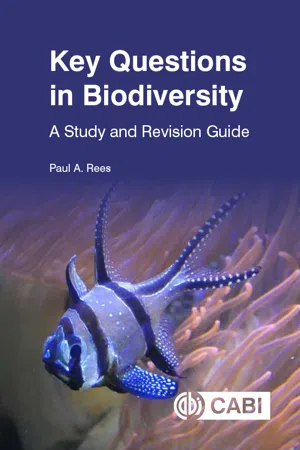
- 256 pages
- English
- ePUB (mobile friendly)
- Available on iOS & Android
About this book
An understanding of biodiversity is an important requirement of a wide range of programmes of study including biology, zoology, wildlife conservation and environmental science. This book is a study and revision guide for students following such programmes in which biodiversity is an important component. It contains 600 multiple-choice questions (and answers) set at three levels - foundation, intermediate and advanced - and grouped into 10 major topic areas: 1. Principles of classification and taxonomy 2. Comparative anatomy and physiology3. Protoctists, monerans, fungi, lichens and acellular organisms4. 'Lower' plants and pteridophytes 5. Seed-bearing plants6. Sponges, cnidarians, nematodes and minor animal phyla7. Platyhelminths, annelids and molluscs8. Arthropods and echinoderms9. Fishes, amphibians and reptiles10. Birds and mammalsThe book has been produced in a convenient format so that it can be used at any time in any place. It allows the reader to learn and revise the meaning of terms used in animal and plant classification, the principles of comparative physiology, and the characteristics of, and diversity in, the major animal and plant taxa. The structure of the book allows the study of one topic area or group of taxa at a time, progressing through simple questions to those that are more demanding. Many of the questions require students to use their knowledge to identify organisms and biological structures from drawings or photographs.
Frequently asked questions
- Essential is ideal for learners and professionals who enjoy exploring a wide range of subjects. Access the Essential Library with 800,000+ trusted titles and best-sellers across business, personal growth, and the humanities. Includes unlimited reading time and Standard Read Aloud voice.
- Complete: Perfect for advanced learners and researchers needing full, unrestricted access. Unlock 1.4M+ books across hundreds of subjects, including academic and specialized titles. The Complete Plan also includes advanced features like Premium Read Aloud and Research Assistant.
Please note we cannot support devices running on iOS 13 and Android 7 or earlier. Learn more about using the app.
Information
1 Principles of Classification and Taxonomy
Foundation
Taxon | A | B | C | D |
Platyhelminthes | Segmented worms | Flatworms | Roundworms | Flatworms |
Annelida | Roundworms | Roundworms | Flatworms | Segmented worms |
Nematoda | Flatworms | Segmented worms | Segmented worms | Roundworms |
Table of contents
- Cover
- Title page
- Copyright
- Contents
- Dedication
- About the Author
- Preface
- Acknowledgements
- How to Use This Book
- 1. Principles of Classification and Taxonomy
- 2. Comparative Anatomy and Physiology
- 3. Protoctists, Monerans, Fungi, Lichens and Acellular Organisms
- 4. ‘Lower’ Plants and Pteridophytes
- 5. Seed-bearing Plants
- 6. Sponges, Cnidarians, Nematodes and Minor Animal Phyla
- 7. Platyhelminths, Annelids and Molluscs
- 8. Arthropods and Echinoderms
- 9. Fishes, Amphibians and Reptiles
- 10. Birds and Mammals
- 11. Answers
- References
- Back Cover